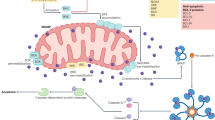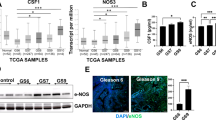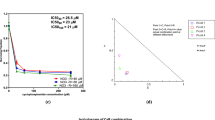Abstract
Apoptosis in response to stress signals activates effector caspases known to be regulated by the release of cytochrome c (Cyt c) from mitochondria and the subsequent ATP-dependent activation of the death regulator apoptotic protease-activating factor 1 (Apaf-1). Experiments were carried out to determine whether the release of Cyt c is evoked by NO□ in RAW 264.7 macrophages and to position signaling components relative to mitochondria. S-nitrosoglutathione and spermine-NO caused a fast p53 accumulation, followed by Bcl-xL downregulation, Cyt c release, and caspase activation. These alterations were absent in p53 antisense expressing macrophages (RΔp53asn-11). In Bcl-2 overexpressing cells (Rbcl2-14) Cyt c relocation and caspase activation were abrogated although p53 accumulation remained intact. The use of caspase inhibitors revealed Cyt c release and decreased Bcl-xL expression to be caspase independent. ATP-depleted cells showed a shift from apoptosis towards necrosis and no p53 accumulation or caspase activation upon NO□ addition. Conclusively, NO□-mediated apoptosis in macrophages is entirely controlled by the mitochondrial pathway with the implication that Cyt c relocation demands p53 accumulation. Moreover, pulse-chase-experiments in combination with the ATP-depletion protocol identified p53 accumulation and stabilization as an energy requiring process. This allowed to dissect two ATP-dependent steps, one is in association with Apaf-1 formation, while the other resides in p53 accumulation.
This is a preview of subscription content, access via your institution
Access options
Subscribe to this journal
Receive 50 print issues and online access
$259.00 per year
only $5.18 per issue
Buy this article
- Purchase on SpringerLink
- Instant access to full article PDF
Prices may be subject to local taxes which are calculated during checkout







Similar content being viewed by others
References
Adams JM and Cory S. . 1998 Science 281: 1322–1326.
Albina JE, Martin BA, Henry Jr WL, Louis CA and Reichner JS. . 1996 J. Immunol. 157: 279–283.
Bossy-Wetzel E, Newmeyer DD and Green DR. . 1998 EMBO J. 17: 37–49.
Brockhaus F and Brüne B. . 1999 Biochem. J. 338: 295–303.
Brüne B, von Knethen A and Sandau KB. . 1998 Eur. J. Pharmacol. 351: 261–272.
Caelles C, Helmberg A and Karin M. . 1994 Nature 370: 220–223.
Castedo M, Hirsch T, Susin SA, Zamzami N, Marchetti P, Macho A and Kroemer G. . 1996 J. Immunol. 157: 512–521.
Chao DT and Korsmeyer SJ. . 1998 Annu. Rev. Immunol. 16: 395–419.
Chauhan D, Pandey P, Ogata A, Teoh G, Krett N, Halgren R, Rosen S, Kufe D, Kharbanda S and Anderson K. . 1997 J. Biol. Chem. 272: 29995–29997.
Chlichlia K, Peter ME, Rocha M, Scaffidi C, Bucur M, Krammer PH, Schirrmacher V and Umansky V. . 1998 Blood 91: 4311–4320.
Cohen GM. . 1997 Biochem. J. 326: 1–16.
Eguchi Y, Shimizu S and Tsujimoto Y. . 1997 Cancer Res. 57: 1835–1840.
Ferrari D, Stepczynska A, Los M, Wesselborg S and Schulze-Osthoff K. . 1998 J. Exp. Med. 188: 979–984.
Green DR. . 1998 Cell 94: 695–698.
Green DR and Reed JC. . 1998 Science 281: 1309–1312.
Hart TW. . 1985 Tetrahedron Lett. 26: 2013–2016.
Hu Y, Benedict MA, Wu D, Inohara N and Nunez G. . 1998 Proc. Natl. Acad. Sci. USA 95: 4386–4391.
Kluck RM, Bossy-Wetzel E, Green DR and Newmeyer DD. . 1997 Science 275: 1132–1136.
Kroemer G, Zamzami N and Susin SA. . 1997 Immunol. Today 18: 44–51.
Lee JM. . 1998 Oncogene 17: 1653–1662.
Leist M, Single B, Castoldi AF, Kuhnle S and Nicotera P. . 1997 J. Exp. Med. 185: 1481–1486.
Leist M, Volbracht C, Fava E and Nicotera P. . 1998 Mol. Pharmacol. 54: 789–801.
Li P, Nijhawan D, Budihardjo I, Srinivasula SM, Ahmad M, Alnemri ES and Wang X. . 1997 Cell 91: 479–489.
McConkey DJ, Nicotera P, Hartzell P, Bellomo G, Wyllie AH, and Orrenius S. . 1989 Arch. Biochem. Biophys. 269: 365–370.
Messmer UK, Lapetina EG and Brüne B. . 1995 Mol. Pharmacol. 47: 757–765.
Messmer UK and Brüne B. . 1996a Biochem. J. 319: 299–305.
Messmer UK, Reed JC and Brüne B. . 1996b J. Biol. Chem. 271: 20192–20197.
Messmer UK, Reimer DM and Brüne B. . 1998 Eur. J. Pharmacol. 349: 333–343.
Moreno MB, Memon SA and Zacharchuk CM. . 1996 J. Immunol. 157: 3845–3849.
Newmeyer DD, Farschon DM and Reed JC. . 1994 Cell 79: 353–364.
Oren M. . 1994 Semin. Cancer Biol. 5: 221–227.
Pan G, O'Rourke K and Dixit VM. . 1998 J. Biol. Chem. 273: 5841–5845.
Patel T, Gores GJ and Kaufmann SH. . 1996 FASEB J. 10: 587–597.
Pitkanen K, Haapajarvi T and Laiho M. . 1998 Oncogene 16: 459–469.
Reed JC, Jurgensmeier JM and Matsuyama S. . 1998 Biochim. Biophys. Acta Bioenergetics 1366: 127–137.
Sakaguchi K, Sakamoto H, Lewis MS, Anderson CW, Erickson JW, Appella E and Xie D. . 1997 Biochemistry 36: 10117–10124.
Soengas MS, Alarcón RM, Yoshida H, Giaccia AJ, Hakem R, Mak TW and Lowe SW. . 1999 Science 284: 156–159.
Stassi G, de Maria R, Trucco G, Rudert W, Testi R, Galluzo A, Giordano C and Trucco M. . 1997 J. Exp. Med. 8: 1193–1200.
Thornberry NA and Lazebnik Y. . 1998 Science 281: 1312–1316.
Vander Heiden MG, Chandel NS, Williamson EK, Schumacker PT and Thompson CB. . 1997 Cell 91: 627–637.
Vaux DL and Strasser A. . 1996 Proc. Natl. Acad. Sci. USA 93: 2239–2244.
Whitesell L, Mimnaugh EG, De Costa, B, Myers, CE and Neckers LM. . 1994 Proc. Natl. Acad. Sci. USA 91: 8324–8328.
Wulff K and Döppen W. . (1985). In: Bergmeyer HU. (ed Methods of Enzymatic Analysis Vol. 7, Verlag Chemie: Weinheim pp. 357–364.
Wyllie AH, Kerr JF and Currie AR. . 1980 Int. Rev. Cytol. 68: 251–306.
Yang J, Liu X, Bhalla K, Kim CN, Ibrado AM, Cai J, Peng T, Jones DP and Wang X. . 1997 Science 275: 1129–1132.
Zamzami N, Susin SA, Marchetti P, Hirsch T, Gomez-Monterrey I, Castedo M and Kroemer G. . 1996 J. Exp. Med. 183: 1533–1544.
Acknowledgements
We thank Brigitte Rogge for excellent technical assistance. This work was supported by the Deutsche Forschungsgemeinschaft and the Deutsche Krebshilfe.
Author information
Authors and Affiliations
Rights and permissions
About this article
Cite this article
Brockhaus, F., Brüne, B. p53 accumulation in apoptotic macrophages is an energy demanding process that precedes cytochrome c release in response to nitric oxide. Oncogene 18, 6403–6410 (1999). https://doi.org/10.1038/sj.onc.1203058
Received:
Revised:
Accepted:
Published:
Issue date:
DOI: https://doi.org/10.1038/sj.onc.1203058
Keywords
This article is cited by
-
Kaurane diterpenes protect against apoptosis and inhibition of phagocytosis in activated macrophages
British Journal of Pharmacology (2007)
-
Radiation-induced genomic instability and bystander effects: inter-related nontargeted effects of exposure to ionizing radiation
Oncogene (2003)
-
Sodium nitroprusside enhances TRAIL-induced apoptosis via a mitochondria-dependent pathway in human colorectal carcinoma CX-1 cells
Oncogene (2001)
-
Inflammatory-type responses after exposure to ionizing radiation in vivo: a mechanism for radiation-induced bystander effects?
Oncogene (2001)



